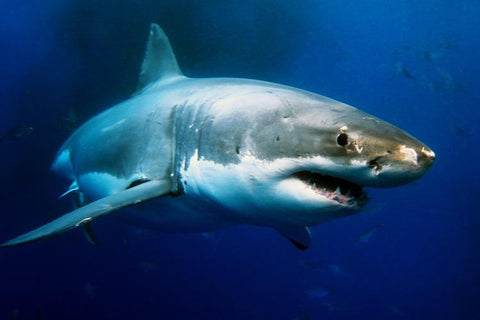
How 1916’s Matawan Man-Eater Made Us Afraid of Sharks Today
From every year's Shark Week programming to bull sharks swimming in the streets of Fort Myers, Florida, after Hurricane Ian, it seems only natural to have a healthy fear of man-eating sharks.
But modern America's outsized galeophobia — and even the movie "Jaws" — wouldn't have come be to be if hadn't been for a real marine monster that terrorized New Jersey in 1916.
The Shark's First victim
The first victim of the summer of 1916 was a 28-year-old Philadelphia man named Charles Vansant, who had come to the southern New Jersey resort town of Beach Haven with his family. Wading out into the ocean water with his dog, Vansant suddenly began screaming for help. Bystanders and a lifeguard finally realized he wasn't calling for his dog, but it was too late: A shark had eaten Vansant's thigh down to the bone. Two men scrambled to get Vansant to land — the shark chasing them the whole way — but it was too late. Vansant bled out in a hotel lobby.
Though Vansant's death was reported in local newspapers, it was mostly brushed off as an unusual, one-off incident.
The Jersey Shore UNder Attack
Five days later, about 45 miles to the north off of Spring Lake, New Jersey, 27-year-old Swiss hotel worker Charles Bruder was swimming 400 miles offshore when people on the beach saw the water around him turn red as he began screaming. Two lifeguards rowed out to him and hauled him into a lifeboat, but both his legs were gone.
Recommended for you
"A shark bit me! Bit my legs off!" he howled.
Bruder died before he made it back to land.
Bruder's death by shark, coming so soon after Vansant's, made national news. Hotels along the Jersey Shore suffered as tourists abandoned the beaches, and those who did venture into the surf reported unverified shark sightings from Connecticut and Coney Island to Alabama and Jacksonville, Florida. Self- appointed shark hunters took to boats and patrolled the New Jersey coastline near the attacks.
At that point, sharks were even less understood than they are now. Nevertheless, after the Bruder attack, three scientists addressed the public in a hastily assembled press conference at the American Museum of National History in New York City. A third shark attack was unlikely, they reassured everyone.
They were wrong.
GET HISTORY 'S GREATEST TALES—RIGHT IN YOUR INBOX
Subscribe to our Historynet Now! newsletter for the best of the past, delivered every Wednesday.
Close
Thank you for subscribing!
Submit
The Matawan Monster
Two men had been killed in a single week by possibly a single shark, but it wasn't until nearly another week had passed that the shark attacks of 1916 turned into full-blown hysteria.
On July 12, 30 miles north of the Bruder attack, local boys were playing in Matawan Creek with their dog. No one could have anticipated what happened next — the creek was 1.5 miles from the ocean, and the water was brackish, not salty. But as they splashed around, the boys realized that what they'd thought was a dark log floating nearby had a dorsal fin. The shark pulled Lester Stilwell, 11, under the water.
Would-be rescuer Stanley Fischer, 24, dove in to try to get Stilwell back — not realizing he'd jumped into the water with a killer shark. The shark bit Fischer on the thigh, and he died from the blood loss.
But the shark wasn't done. Only 30 minutes after it left a dying Fischer, there was a fifth and final shark attack half a mile away. Fourteen-year-old Joseph Dunn, visiting from New York City, was in the creek when the shark bit his left leg. Dunn's brother barely pulled the boy from the killer fish's maw. Dunn lost his leg and spent a month in a hospital but ultimately lived.
Shark Hysteria consumes the nation
After the triple attacks in Matawan, the U.S. went shark crazy. The mayor of Matawan offered a reward for the shark, and shark hunters scoured Matawan Creek, even dynamiting the waters in a no-holds-barred effort to bring the fish to justice. All along the East Coast, seemingly anyone with a boat rode the waves, killing anything with a dorsal fin. The House of Representatives directed thousands to eliminate the Jersey Shore shark threat, and even the president had to get involved — Woodrow Wilson convened his cabinet to find a solution, and the secretary of the treasury proposed that man-killing sharks become a priority for the Coast Guard.
Two days after the shark killed Stilwell and Fischer, an unlikely duo — a New York City taxidermist and a lion tamer from Barnum & Bailey — caught a young, 8-foot great white shark in Raritan Bay, not far from the mouth of Matawan Creek. The shark attacked their rowboat and almost sank it until the lion tamer killed it with his oar.
There were no further shark attacks.
What was the Matawan Man-Eater?
It's still debated whether the great white caught on July 14, 1916, was the real killer, with many modern experts saying it's more likely the deaths were the work of a bull shark. Others focus on what could have caused such unusual shark behavior, even blaming German U-boats operating in the Atlantic.
But the killer shark of 1916 wasn't done yet. In 1974, novelist Peter Benchley drew on the events of the Jersey Shore when writing "Jaws," which Steven Spielberg turned into the movie that made his career the next year.
Once again, America was afraid to go in the water.
historynet magazines
Our 9 best-selling history titles feature in-depth storytelling and iconic imagery to engage and inform on the people, the wars, and the events that shaped America and the world.
